Recent Articles
Popular Makes
Body Types
2014 Ford Escape 2.0 Titanium Compact SUV Review
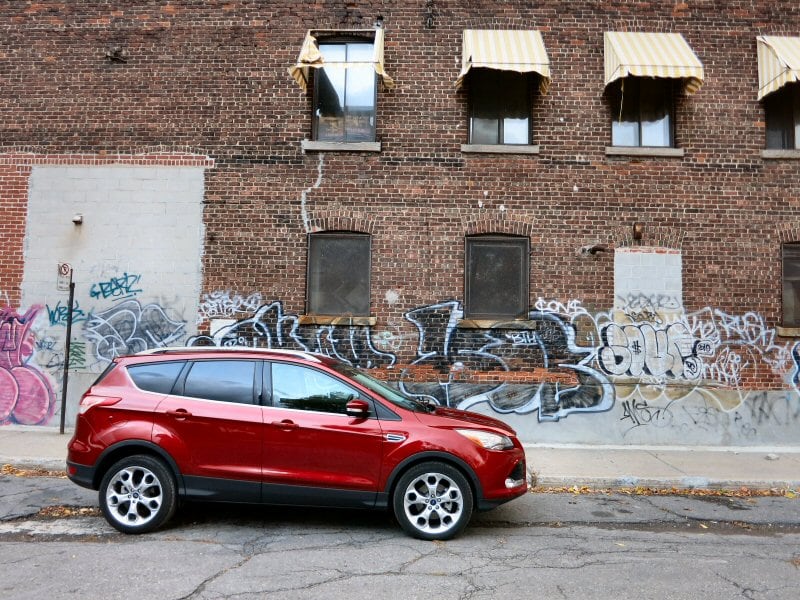
2014 Ford Escape Titanium ・ Photo by Benjamin Hunting
The winds of change affect even icons of the automotive industry, but it's fair to say that one year after its head-to-toe redesign, the 2014 Ford Escape has managed to maintain the momentum that made it the most popular compact SUV in America. This accomplishment is made even more impressive in light of the fact that the Escape went from a traditional body-on-frame design to a more modern unibody platform in the process - a transition that can often re-shape the appeal of a vehicle for its original audience.
I spent a week with the 2014 Ford Escape in 2.0-liter Titanium trim and found it easy to see why this little hauler has remained near and dear to the hearts of so many families. With style and technology that's not as apparent in rivals like the Toyota RAV4 and the Honda CR-V, coupled with the power of the brand's top-shelf EcoBoost four-cylinder drivetrain, the Escape has established a clear template for sticking near the top of its class.
Models and Prices
The 2014 Ford Escape breaks down into three models: the S, the SE, and the Titanium. The Ford Escape S starts at an MSRP of $22,610 and comes standard with the SYNC vehicle interface, Bluetooth connectivity, a CD player, a rearview camera, power windows and door locks, air conditioning, 17-inch steel wheels, cruise control, and a USB input. Moving up to the Escape SE (MSRP $25,060) installs rims instead of steelies (still 17 inches in diameter), tinted windows, a power driver's seat, satellite radio, fog lights and automatic headlights, Ford's number pad door entry system, and reclining rear seats, while the Escape Titanium (MSRP $28,610) pours on gear such as the MyFord Touch system, heated leather seats, an upgraded stereo, dual automatic climate control, parking assistance, 18-inch rims, remote start with keyless entry and ignition, Ford's ambient cabin lighting, and a power tailgate.
My tester was a Ford Escape Titanium outfitted with four-wheel drive and a 2.0-liter EcoBoost four-cylinder engine. It also came with Equipment Group 401A (HID headlights, blind spot monitoring system, active parking assistance, rain-sensing wipers), a panoramic sunroof, and a navigation system. The total MSRP for the vehicle I drove came to $35,140.
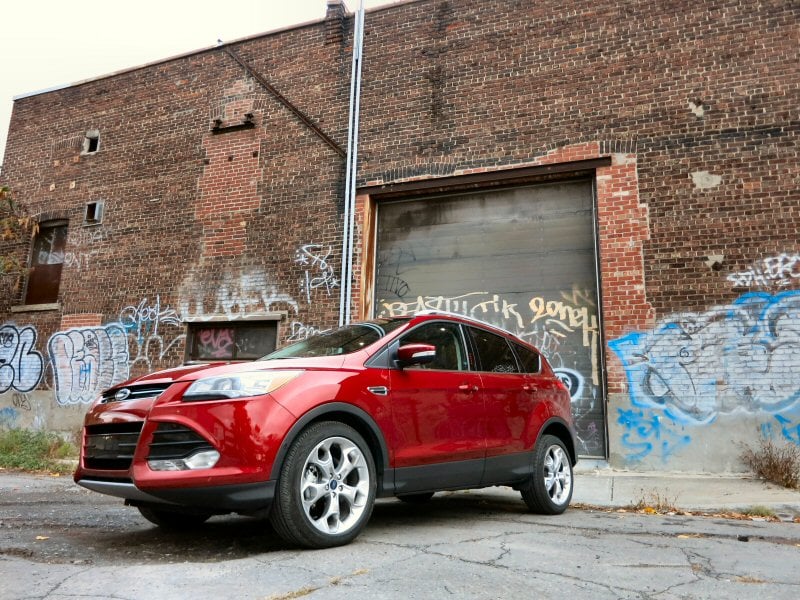
Photo by Benjamin Hunting
Design
- The 2014 Ford Escape 2.0 Titanium is unchanged for the current model year.
The 2014 Ford Escape 2.0 Titanium is the priciest, and therefore the best-adorned member of the SUV's family, and yet it still manages to maintain a modesty that keeps it a hit with family shoppers not interested in flash. Aside from slit vents carved into the front fenders and chrome above the license plate mount and underlining the side windows, the Escape Titanium is a restrained affair that features a stubby hood, broad sheet metal, and a healthy grouping of character lines carved into almost every panel. It's a simple design set off perfectly by the 19-inch rims of my tester, but it has a bit more personality than what one would get from the more anonymous RAV4. Still, if you're seeking a more individual approach to the compact crossover concept, look to either Hyundai (the Santa Fe Sport) or Kia (the Sorento).
Inside the Escape is simple, but still pleasant. I could have done without the faux carbon fiber trim on the dash and center console, but the SUV's touchscreen is nicely framed by HVAC vents, and the dashboard's overall shape engages the eye. Practicality is the order of the day for the Ford's cabin, although the Escape offers enough detail for the Titanium model's interior to justify its premium pricing without pushing too far into Lincoln territory.
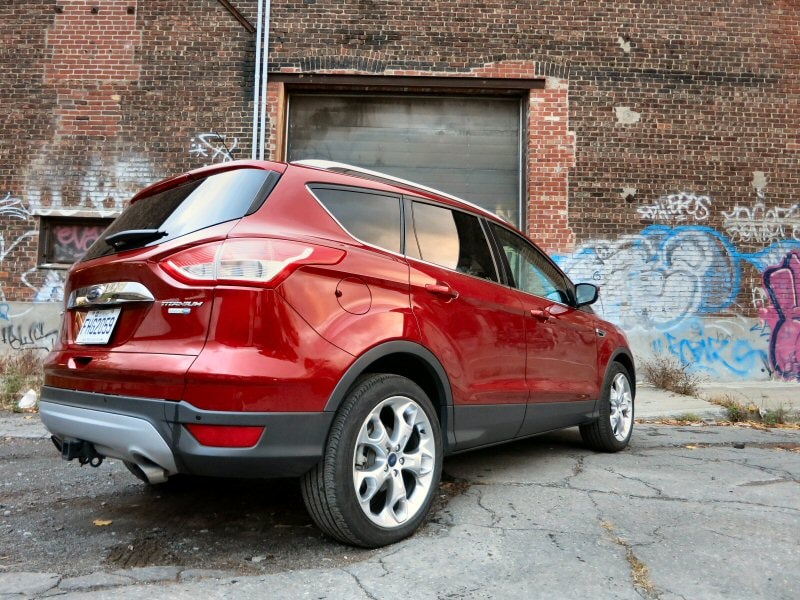
Photo by Benjamin Hunting
Comfort and Cargo
- The 2014 Ford Escape 2.0 Titanium does not introduce any new features.
The 2014 Ford Escape 2.0 Titanium happens to be one of the most practical options in the compact SUV class. While its rear bench might not appear particularly spacious at first glance, clever scalloping of the front two seatbacks creates a good amount of room for those riding in the third and fourth positions. All of the perches in the Escape feel a little high, with a near theatre-like experience for rear occupants, but it's not enough to give you vertigo. The sport-utility vehicle's small external footprint also conceals a vast capacity for hauling your gear around: there's 68 cubic feet of total space available inside the Ford with the rear seat folded forward, and half that should you be carrying a full load of passengers. This places the Escape near the front of the compact pack.
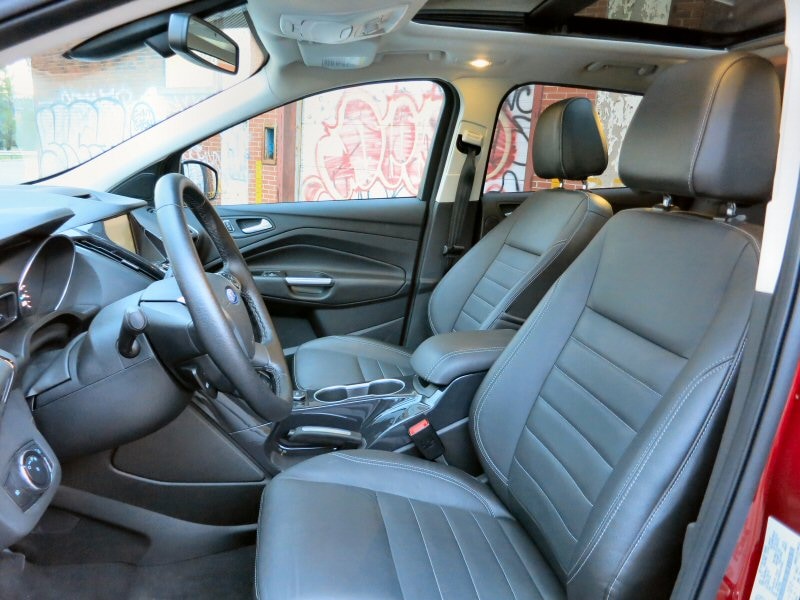
Photo by Benjamin Hunting
Features and Controls
- All versions of the 2014 Ford Escape now come with a backup camera as standard equipment.
- SYNC is also standard across the board.
The 2014 Ford Escape 2.0 Titanium bases much of its ownership experience around the MyFord Touch vehicle interface, a touchscreen system that works together with the SYNC voice command and mobile device integration feature to control a vast array of the SUV's features. This includes entertainment, communications, climate, and navigation, and while for the most part it works well there are a few irritants to work through on a daily basis. One is the size and position of the tabs on the main home screen, which is divided into four basic sections. To access, say, the stereo system, you have to touch a narrow strip of color at the bottom left of the screen, a feat that isn't easy even with small fingers and essentially impossible while wearing gloves.
Another weird thing that happened during my week with the Ford Escape had to do with the vehicle's text message system, which can read out loud or display incoming texts as they arrive on your Bluetooth-paired phone. Every half hour or so while driving I would be notified by the Escape of a new incoming text, which would be read to me and stored in the MyFord Touch system. The only issue was, none of these texts appeared on my phone, and when I contacted the various individuals they were being 'sent' from, it turns out that they hadn't texted me, period. What I finally figured out was that the Escape was dredging up texts from the past from my phone and randomly presenting them as new. This continued throughout my entire time with the vehicle.
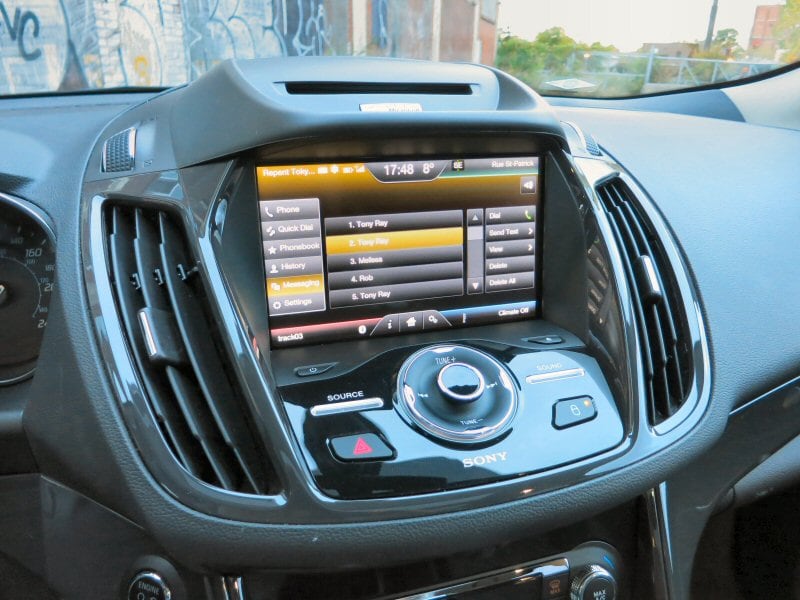
Photo by Benjamin Hunting
Safety and Ratings
- The 2014 Ford Escape 2.0 Titanium does not introduce any new safety equipment.
The 2014 Ford Escape 2.0 Titanium offers the same complement of airbags as any other member of the Escape family, including full-length side curtain units, seat-mounted side airbags up front, dual forward airbags, and a knee airbag for the driver. You also get the MyKey feature across the board, which allows owners to set speed limits for the SUV when lending it out, as well as control the volume of the stereo system. The Escape that I drove came equipped with an optional blind spot monitoring system, which is only available on the Titanium trim.
2014 Ford Escape 2.0 Titanium Crash-Test Ratings: The Ford Escape was rated four stars out five for overall crash protection by the NHTSA, while the IIHS awarded the SUV its highest score of 'Good' in each important crash test category.
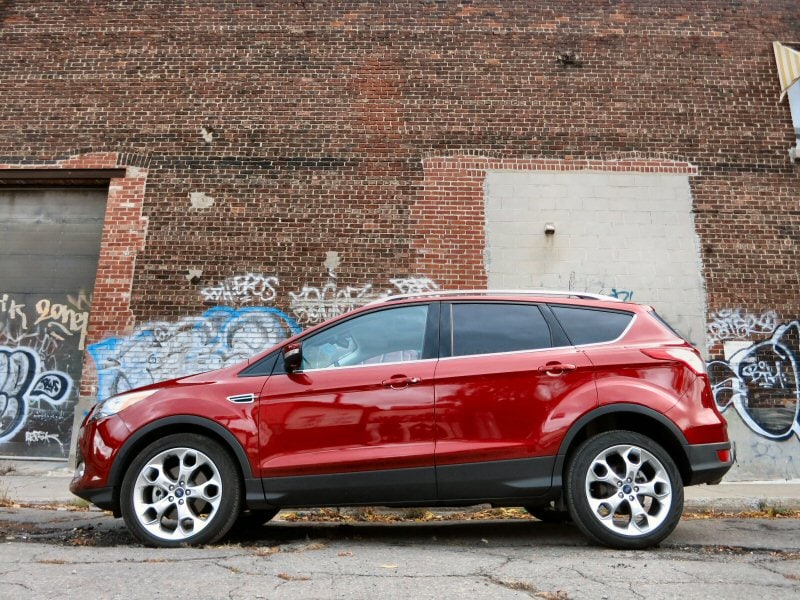
Photo by Benjamin Hunting
Engines and Fuel Economy
- The 2014 Ford Escape 2.0 Titanium does not introduce any new drivetrains compared to the previous model year.
There are three engines available with the 2014 Ford Escape, although only two of them can be had when ordering the Titanium trim level. Base SUVs feature a 2.5-liter four-cylinder rated at 168 horsepower and 167 lb-ft of torque, but standard on all other editions of the Escape is a turbocharged 1.6-liter EcoBoost four-cylinder that delivers 178 horses and 184 lb-ft of twist. Fuel mileage for the two engines is remarkably close, with the 1.6-liter eking out a slight lead with 23-mpg city and 33-mpg highway.
The vehicle I drove featured a 2.0-liter turbocharged EcoBoost four-cylinder good for 240 horsepower and 270 lb-ft of torque. As with all other versions of the vehicle, a six-speed automatic transmission handles the gear shifting duties, and fuel mileage is listed at 22-mpg around town and 30-mpg on the highway. My vehicle also featured optional all-wheel drive, which cuts down very slightly on efficiency.
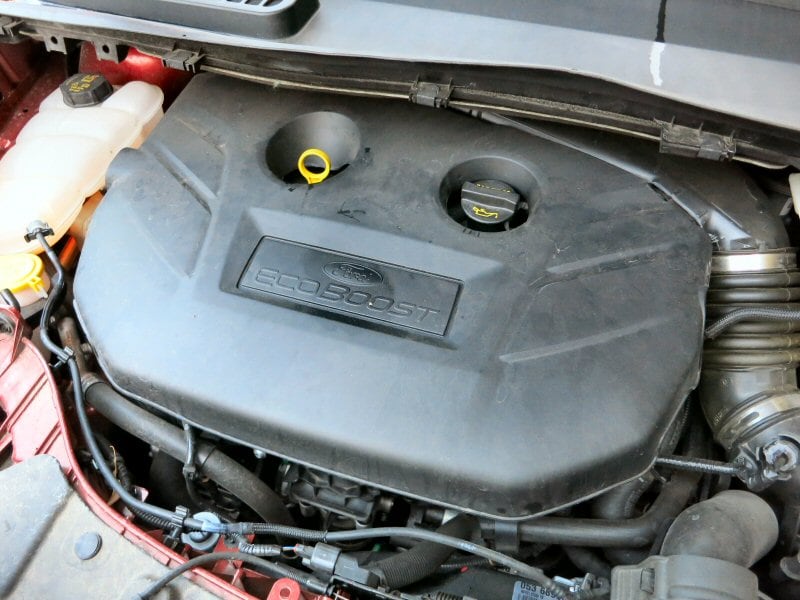
Photo by Benjamin Hunting
Driving Impressions
The 2014 Ford Escape 2.0 Titanium is remarkably car-like in its daily driving demeanor. In fact, if it weren't for the additional ground clearance of the SUV pushing its center of gravity towards the sky - a shift in balance further accented by the weight of its panoramic sunroof - then it would be difficult to tell the difference between the Escape and a compact hatchback out on the road. The additional weight of the sport-utility vehicle was more than mitigated by the strong response of the EcoBoost engine's turbocharged torque. I never felt like I was sitting there waiting for the design to spool up and provide me with usable power, unlike with the 1.6-liter unit, and I heartily recommend spending more on the 2.0-liter option (which also has the benefit of not having been involved in nearly as many safety recalls as the smaller EcoBoost motor).
The Ford Escape's handling prowess is matched by a comfortable ride that absorbs bumps when it needs to but doesn't completely isolate pilots and passengers. It's not that the Escape is ultra-engaging in the way one would expect from a performance-oriented SUV, but the balance it provides between coddling and communicating is laudable in such an affordably-priced vehicle.
I didn’t have much call to test out the Escape's optional four-wheel drive system, as conditions remained dry and roads stayed clear throughout our time together. However, unlike a traditional SUV it's important to keep in mind that Ford has designed the Escape as a front-wheel drive vehicle first, which means that the rear axles are only ever called into action when a loss of traction is detected. You can't really take the Ford Escape through the mud and the muck like a Jeep, but I don't think most potential buyers will care: they're going to be more concerned about how the vehicle will behave during slippery conditions on the morning commute.
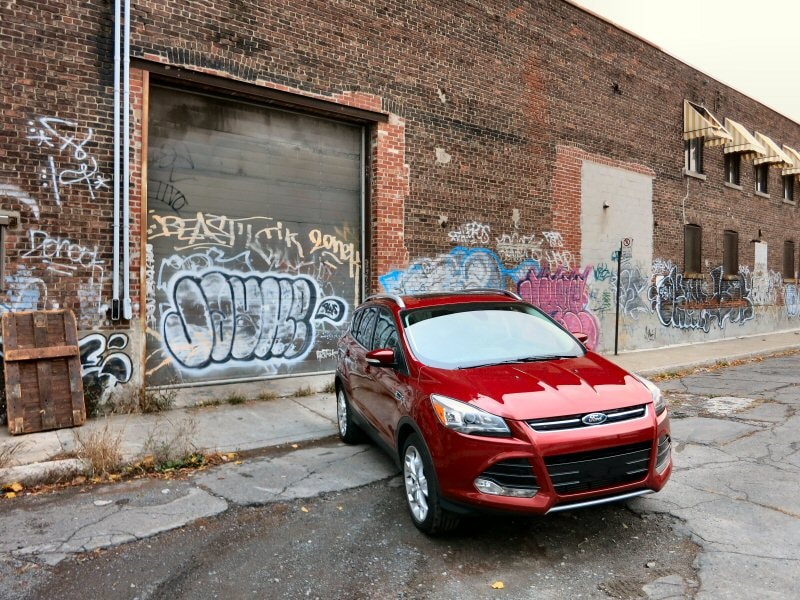
Photo by Benjamin Hunting
Final Thoughts
The 2014 Ford Escape 2.0 Titanium is a strong choice for families who need more space than a compact hatchback along with the added security of all-wheel drive. It's also enormous inside for its class, offering practicality well beyond its size. As appealing as any of its rivals - and maybe a bit more interesting to drive - the Ford Escape 2.0 Titanium is loaded to the brim with features designed to ease the pain of getting from point A to point B. For those seeking more basic transportation then the 2.5-liter Escape S is a respectable option as well, as I don't feel the performance benefits warrant paying more for the 1.6-liter EcoBoost engine (unless you absolutely need all-wheel drive - it's not offered with the base SUV).
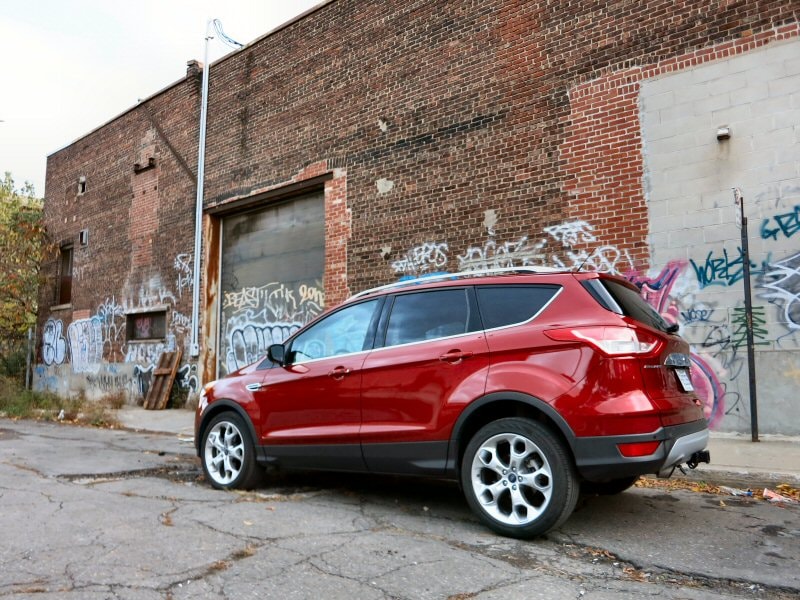
Photo by Benjamin Hunting
Pros and Cons
Pros:
- Well priced when considering included features
- 2.0-liter EcoBoost engine offers more than enough power
- Available all-wheel drive
- Conservative yet attractive styling
- Spacious interior for hauling gear
- Usable second row of seating
Cons:
- MyFord Touch system still not 100 percent user-friendly
- Weird ghost texts from the past via SYNC mobile phone connection kept things spooky
- Automated parking system is hit or miss
- 2.5-liter engine availability on SE trim would be a nice add.
Ford Canada supplied the vehicle for this review.
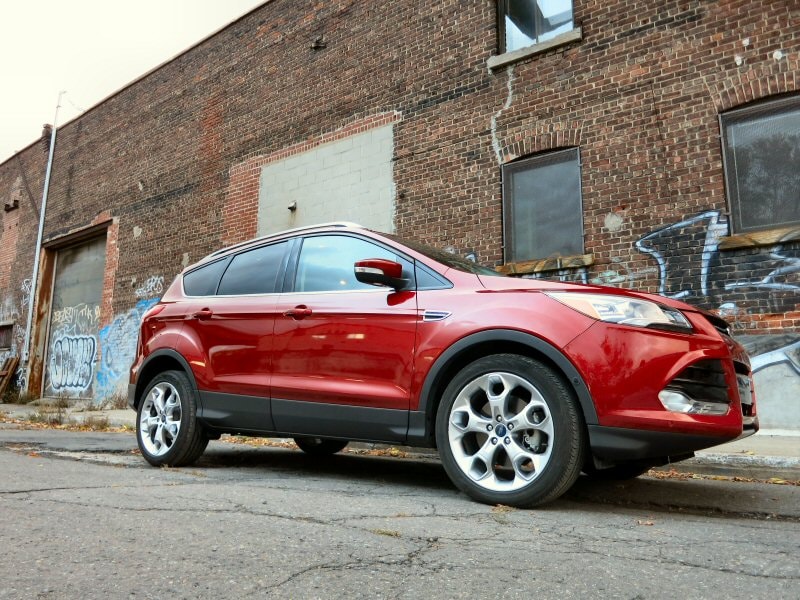
Photo by Benjamin Hunting